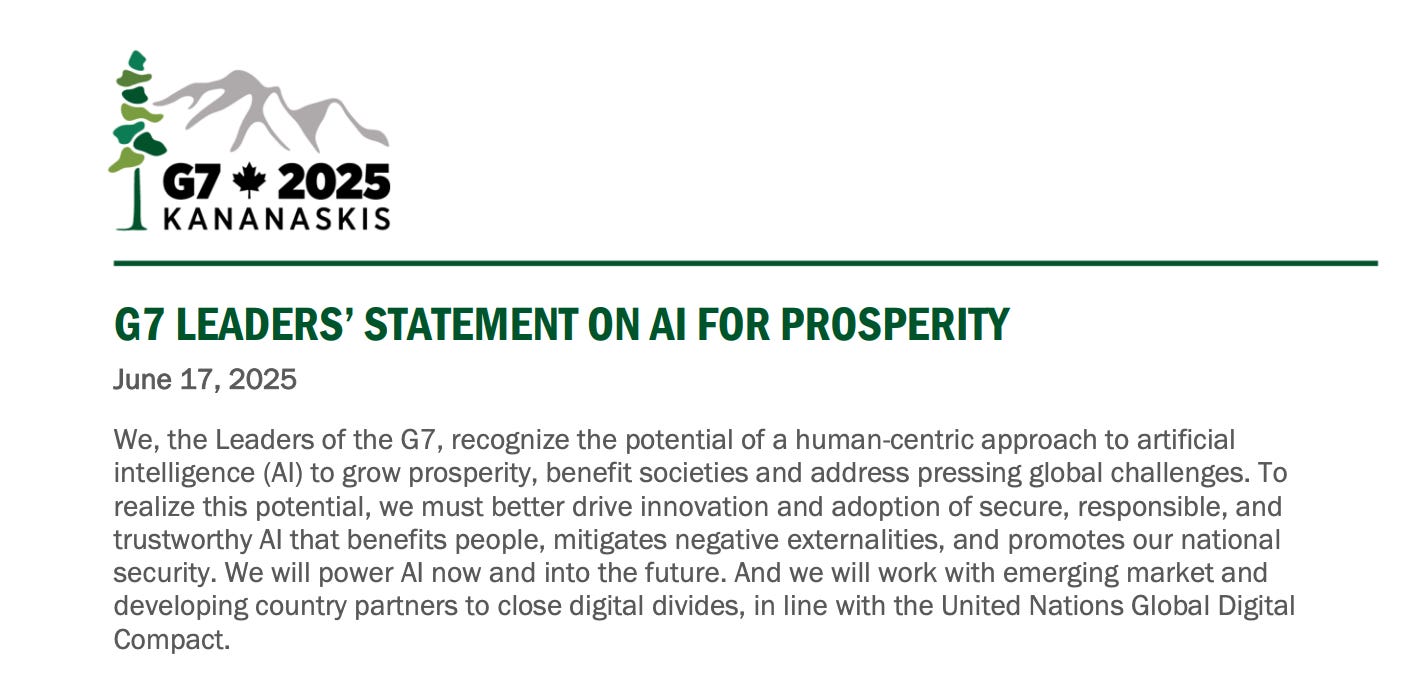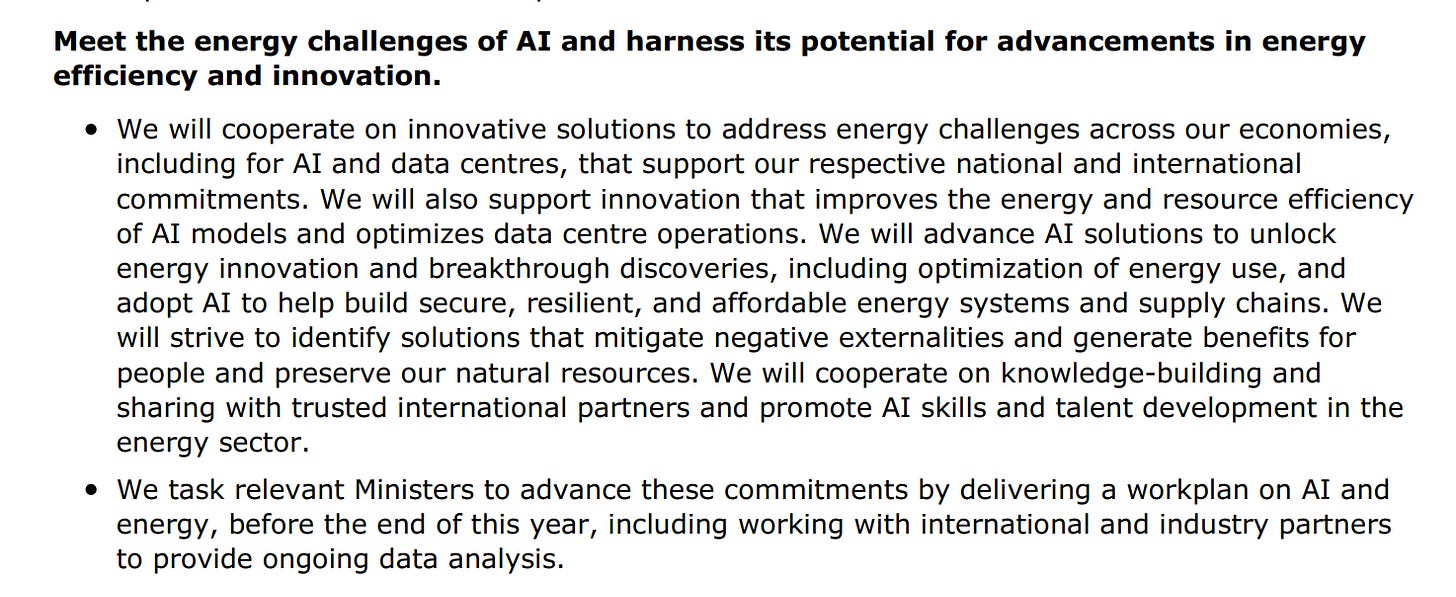Issue 18: G7 Leaders Are Becoming Worried About AI’s Energy Use
Global leaders are now confronting AI’s growing energy demands with real plans to make future AI tech more sustainable.
AI is powering everything from your phone’s assistant to major breakthroughs in science, but behind the scenes, it is putting serious pressure on the world’s energy systems. At the recent G7 summit, global leaders discussed this growing issue, laying out plans to make AI more energy-efficient and sustainable. This newsletter breaks down what the G7 actually agreed to, and why it matters more than ever.
What the G7 Just Agreed On: A Global Vision for Responsible AI
The G7 leaders recently gathered in scenic Kananaskis and, instead of just shaking hands for the cameras, they did something quite serious and surprisingly specific.
They agreed on a shared blueprint for artificial intelligence that, if followed, might just keep AI from becoming a sci-fi disaster movie.
At the centre of the declaration is a promise to build and use AI in ways that actually help people, serve communities, and make public services less frustrating.
The declaration opens with polite global optimism. The leaders agree AI should serve society and help tackle some of the world's most irritating problems, from inefficient bureaucracy to stubborn digital divides.

The leaders also acknowledge that the energy demands of AI are growing fast, and if no one does anything about it, future generations might be left with AI agents that work but no electricity to run them.
Canada, holding the G7 presidency, is particularly proud of its new initiative, the G7 GovAI Grand Challenge.
This initiative sounds like the Olympics for public sector nerds. However, it will serve as a space where governments can pitch their trickiest service delivery problems and then crowdsource tech solutions with the kind of optimism last seen in startup pitch decks.
To make this work, they are also launching something called the G7 AI Network or GAIN, a collaboration to share government-built AI tools across member countries.
These tools will apparently be open source and shareable, meaning one country’s clever public sector code could become another country’s digital lifeline.
The declaration also includes a firm commitment to make AI work for small and medium-sized businesses.
Leaders describe SMEs as the economic backbone, which is probably true, although that backbone often carries most of the weight while still waiting for stable Wi-Fi.
Through a new AI Adoption Roadmap, G7 countries will help SMEs figure out how to use AI in a way that is safe, efficient and not terrifying. This includes everything from investment in digital infrastructure to actual real-world case studies so smaller companies are not left copying whatever the biggest tech company did three years ago.
Energy consumption gets its own serious nod in the declaration, and rightly so.
AI models are now so large and power-hungry that running them can sometimes feel like operating a very grumpy spaceship.
The G7 acknowledges this and wants to cooperate on making AI models and data centres more efficient. They also want to use AI itself to improve energy systems, which sounds like asking your computer to fix your house’s wiring while it is still learning to plug itself in. Still, progress is progress.
Another highlight is the G7 commitment to work with emerging markets and developing countries. Rather than hoarding AI tools behind some invisible paywall, the declaration calls for a partnership approach.
The plan is to support locally led innovation, share infrastructure, and connect universities and researchers so AI becomes something everyone can use, not just the usual club of rich and tech-savvy nations.
There is even talk of collaborating through global initiatives with impressive names like AI for Development, AI Hub for Sustainable Development and something called FAIR Forward, which sounds like a social media handle but is actually a capacity-building program.
Overall, the G7 declaration on AI for Prosperity is both ambitious and oddly specific. The leaders have essentially looked at the AI revolution, raised one collective eyebrow and said, with global seriousness, let us try to do this properly.
Whether it results in smoother public services, smarter small businesses, or more energy-efficient algorithms, at least for once the global powers are talking less about regulating AI and more about using them to do something genuinely useful.
AI’s Power Problem
Artificial intelligence is clever. It can write stories, schedule your calendar, and even suggest which socks to wear based on the weather forecast. But behind all that smart behaviour is a not-so-smart side effect.
It utilises significant energy. The more powerful AI becomes, the more energy-hungry it gets, and global leaders are starting to feel the weight of that energy usage.

At this G7 gathering, leaders from the world’s most powerful economies took a serious look at what AI is doing to energy systems and came away with one conclusion. That is why the G7’s new declaration gives energy efficiency a starring role in the discussion.
The G7 leaders have committed to working together on ways to limit AI from wrecking the grid. They know that as more countries plug in more servers, data centres, and machine learning tools, the result could be a surge in demand that turns into a supply chain headache.
So they plan to get ahead of it by redesigning the systems around it so everything becomes smarter, faster and less energy needy.
A big part of the plan involves innovation in data centre operations. According to the G7, this will involve pushing new technologies that help use less power, generate less waste heat, and keep things stable when AI models start showing off.
Another part of the energy plan is the idea of using AI to fix energy itself. Yes, the very thing causing the problem is now being asked to help solve it. The leaders want to support the development of AI applications that can improve how energy is generated, stored and distributed.
For example, they believe AI can help track energy flows, detect faults in power grids and even suggest smarter ways to load-balance electricity.
They also want AI to support breakthroughs in clean energy research. That includes using algorithms to predict weather patterns more accurately for wind farms, simulate new battery designs, and figure out how to make solar panels work harder on cloudy days.
There is a growing interest in designing machine learning models that can do more with less. The G7 calls this “improving energy and resource efficiency”.
G7 leaders say they will work with trusted global partners to share knowledge, train new talent, and compare results. They want engineers and researchers across countries to coordinate their experiments so the next generation of AI developers are not reinventing the same wheel.




